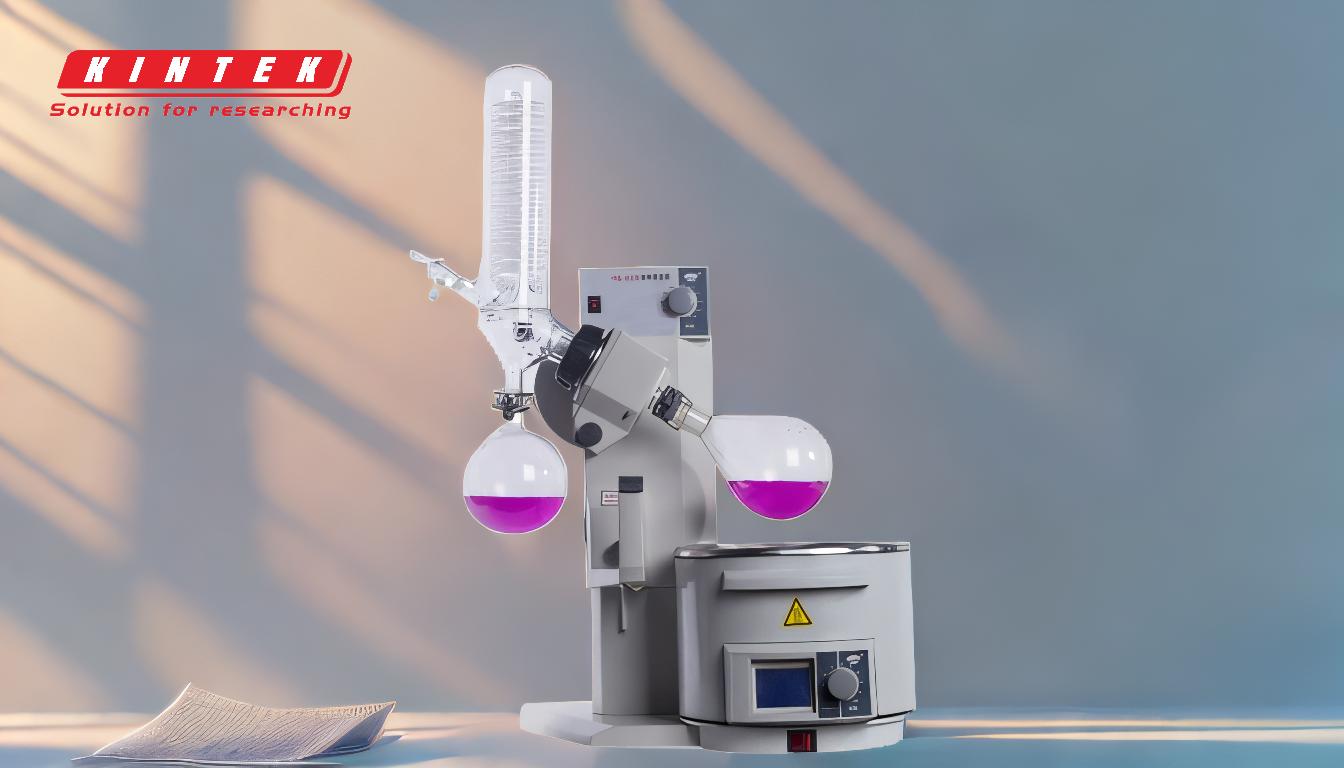A rotary evaporator, or rotovap, is a sophisticated laboratory instrument designed for efficient solvent removal and recovery through vacuum distillation. It operates by reducing the pressure in the system, which lowers the boiling point of the solvent, allowing it to evaporate at lower temperatures. The process involves heating a rotating flask containing the solution, which increases the surface area for evaporation. The solvent vapors are then condensed in a chilled condenser and collected in a receiving flask. The system's efficiency is influenced by factors such as rotation speed, bath temperature, condenser temperature, and vacuum pressure. This method is particularly useful for recovering solvents from heat-sensitive compounds.
Key Points Explained:

-
Basic Principle of Operation:
- Vacuum Distillation: The core principle of a rotary evaporator is vacuum distillation. By reducing the pressure within the system, the boiling point of the solvent is lowered, allowing it to evaporate at a much lower temperature than it would under normal atmospheric pressure. This is crucial for handling heat-sensitive materials.
- Rotating Flask: The flask containing the solution is rotated to increase the surface area of the liquid, which enhances the rate of evaporation. The rotation also helps in creating a thin film of the liquid on the inner surface of the flask, further facilitating evaporation.
-
Key Components:
- Rotating Flask: This is where the solution to be distilled is placed. The flask is typically filled to about 50% of its volume to allow for efficient rotation and evaporation.
- Vacuum Pump: The vacuum pump is essential for creating the low-pressure environment needed for vacuum distillation. It reduces the pressure inside the system, thereby lowering the boiling point of the solvent.
- Heating Bath: The heating bath, usually a water bath, is used to heat the solution in the rotating flask. The temperature of the bath is carefully controlled to ensure that the solvent evaporates at the desired rate without degrading the solute.
- Condenser: The condenser is responsible for cooling the solvent vapors that are produced during evaporation. It is typically chilled to a temperature between -10°C to 0°C, causing the vapors to condense back into liquid form.
- Receiving Flask: The condensed solvent is collected in the receiving flask, which is positioned at the end of the condenser. This allows for easy recovery and reuse of the solvent.
-
Process Parameters:
- Rotation Speed: The speed at which the flask is rotated can significantly affect the rate of evaporation. Higher rotation speeds create a thinner film of liquid on the flask's surface, increasing the surface area and thus the rate of evaporation.
- Bath Temperature: The temperature of the heating bath is critical. It must be high enough to facilitate evaporation but not so high as to cause thermal degradation of the solute.
- Condenser Temperature: The condenser must be kept at a low temperature to ensure efficient condensation of the solvent vapors. The temperature is typically maintained between -10°C to 0°C.
- Vacuum Pressure: The level of vacuum applied is a key factor in determining the boiling point of the solvent. A lower vacuum pressure results in a lower boiling point, allowing for more efficient evaporation at lower temperatures.
-
Applications:
- Solvent Recovery: One of the primary uses of a rotary evaporator is for the recovery of solvents from solutions. This is particularly important in industries where solvents are expensive or need to be reused.
- Concentration of Solutions: Rotary evaporators are also used to concentrate solutions by removing the solvent, leaving behind a more concentrated solute.
- Purification: They can be used for the purification of compounds by removing impurities through distillation.
-
Advantages:
- Efficiency: The combination of vacuum and rotation makes the rotary evaporator highly efficient at removing solvents, even from heat-sensitive materials.
- Versatility: It can handle a wide range of solvents and is adaptable to various laboratory needs.
- Solvent Recovery: The ability to recover and reuse solvents is both economically and environmentally beneficial.
-
Limitations:
- Complexity: The setup and operation of a rotary evaporator can be complex, requiring careful control of multiple parameters.
- Cost: The initial investment and maintenance costs can be high, especially for high-quality models.
- Skill Requirement: Proper operation requires a certain level of skill and experience to ensure optimal performance and safety.
In summary, a rotary evaporator is a versatile and efficient tool for solvent removal and recovery in laboratory settings. Its operation is based on the principles of vacuum distillation, and it comprises several key components that work together to achieve efficient evaporation and condensation. The process is influenced by various parameters, and while it offers numerous advantages, it also has some limitations that need to be considered.
Summary Table:
| Aspect | Details |
|---|---|
| Basic Principle | Vacuum distillation lowers solvent boiling points for efficient evaporation. |
| Key Components | Rotating flask, vacuum pump, heating bath, condenser, receiving flask. |
| Process Parameters | Rotation speed, bath temperature, condenser temperature, vacuum pressure. |
| Applications | Solvent recovery, solution concentration, purification. |
| Advantages | High efficiency, versatility, solvent recovery benefits. |
| Limitations | Complex setup, high cost, requires skilled operation. |
Discover how a rotary evaporator can optimize your lab processes—contact us today!













